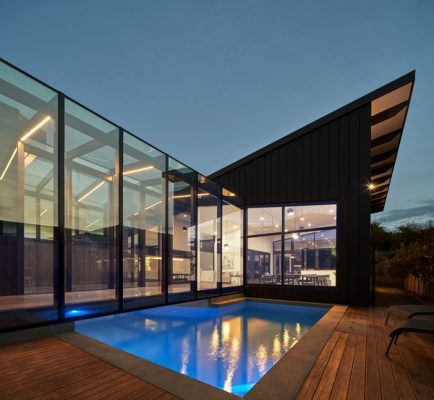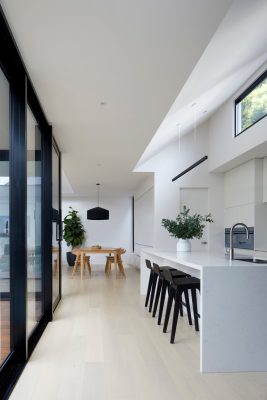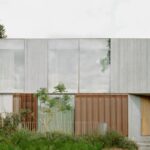U House, Thornbury, Melbourne Real Estate, Australian Building Development, Victoria Architecture Images
U House in Thornbury, Melbourne
27 Sep 2018
U House and Pool
Design: C.Kairouz Architects
Location: Thornbury, Melbourne, Victoria, Australia
The U House is a contemporary extension and renovation of a period home, originally built in the 1920s, in the inner-city suburb of Thornbury, Melbourne. The design brings to life the existing Edwardian cottage which was dark and constrained, by retaining heritage details and injecting it with space, light, connectivity, and a modern edge.
Strong emphasis revolved around updating the home to be an entertainer’s delight and enhance connections, with this in mind a ‘U’ shaped addition with a central courtyard was devised and became the missing link that brought the whole design together and strengthened family ties. This dynamic rear extension brings into balance living requirements, enhancing light, function, and interaction between spaces and their inhabitants.
What was the brief?
The young family came to us after slowly outgrowing their underperforming old home. They loved the vibrant suburb of Thornbury and their character filled street, so moving wasn’t really an option. An entry problem, lack of light, function, and space of the original house, dictated the brief. With busy lives professionally and socially, the clients required a forever home that could help & enhance everyday living, working & entertaining, whilst withstanding the test of time.
What were the key challenges?
The key challenges of the project were firstly to decide on how best to meet the brief while dealing with the site. It also required consideration of how to respect local context in addition to creating a modern home fit for the future. An extension solution was devised, which appreciated the historical value & street aesthetic, but brought new challenges of tempering old with new.
An unrecognizable original entryway of the existing home was also a test. By improving the passageway into the home, it would help to set a standard upon entry and improve the entire home experience from the beginning.
After living in a home with mediocre light quality and connection to the outdoors the clients requested a ‘Light filled House’. Much thought went into creating a plan that would optimize natural daylight at all times of the day.
The brief involved a full program of requirements, especially once the existing home was to be retained, leaving limited leftover space available to play with. This meant devising a clever floorplan that would respond to the client’s needs and wants, while carefully arranging spaces and navigating the restraints.
The orientation also proved problematic, while the front of the property faces north, the rear had to contend with the south. To capitalize on the light in the living areas of the home at the back and avoid a south-facing rear, a courtyard extension was developed which would add the improved functionality while incorporating the best natural light possible with views to the outside.
What were the solutions?
Context
By repurposing the old home & retaining a piece of local history, meant the client could save on construction costs. It also represented a design that was sensitive to the streetscape, had less impact on the environment and respected the local community, while still adapting the dwelling to be fit for modern life.
The good bones of the existing home were perfect for reuse and retaining heritage charm. A careful approach was taken to preserve as much as possible, keeping the exterior as is with just a fresh coat of paint, a new roof and adjustments to the internal layout within the original footprint.
The old homes position at the front meant the best use for this dwelling would be as a private ‘hub’. Where the smaller, subdued, character-filled spaces could perform for relaxation and private use. A 3 bed, 2 bath plan was created from the original, each room refreshed, increasing in area and storage solutions – including access to the roof cavity.
By going out and not up the rear extension was designed to be structurally independent from the old, and to provide easily accessible single level living. It also included pitched nods to period home at the front, replicating angles at entry and wings at rear. These considered forms were essential to echoing the original home design & enhancing light quality, providing space for high windows which provide sunlight, openings to control temperature circulation by catching breezes & removing hot air.
Function
To prevent long corridors, wasted circulation space and encourage strong engagement between the street and the new addition, the original entry was pushed back & opened up to face the street on the right, where old meets new. Here the journey was enhanced with a contrasting pergola structure and pathway guiding the user gently to the door where they land in dedicated foyer zone/rumpus room divided by architectural fins. With significant setback for privacy, a clear glazed doorway was specified for an inviting feel & northern sun to permeate further through the home.
To avoid a south-facing living space a courtyard formation was adopted. Public areas were positioned in the back via the new addition. A ‘U’ shape was created to open the back up to northern light and use biophilic principles where possible. Natural elements of fire, water, plants, sun, and air, were all visible or engaged in each room. Orientated sidewards with plenty of double glazing, including 2 big clerestory windows, spaces harness northern, southern and western light movement and airflow throughout the day.
The layout of the extension is a series of spaces that are knitted together, spilling into one another whilst remaining independent. This entertaining zone acts as a cog in the wheel, mediating 5 interconnected spaces, all revolving around a green courtyard, providing indoor-outdoor living and views. A central pool ties it all together, providing opportunities for reflection, cooling and mood-enhancing qualities.
Lifestyle and function at the core, thoughtful emphasis was on how we live and entertain with connectivity being paramount – peoples connection to one another, with our spaces and the environment. The extension solution heralds open and strong visual and physical relationships with its transparency and shape. Wrapping around the garden and pool, fitted entirely with floor-to-ceiling glazed doors and windows, meant the home has drastically improved opportunities for natural ventilation and can adapt to fluxes in weather or purpose. While the restored, private section of the home celebrates separation, intimacy, and seclusion.
Other internal features such as the generous office which peers across the courtyard and into the living, the integrated bar in the dining room, the hidden pantry, and the concrete credenza in the living room (including fireplace) which flows continuously into the BBQ and outdoor deck. Are reminders of the attention to connectivity and function in the home.
Relationships
A strong focus on integrated process, with constant dialogue between architect, builder & client helped to meet the brief & budget. It was all about clever collaborative ideas & spending on quality essentials that would make a more efficient & adaptable long-term home.
An open dialogue with the neighbors at the rear was instrumental to achieving a great result. It created an opportunity for design negotiations to occur and therefore push the envelope on what could be achieved on the back boundary. With both parties agreeing on a solution that respected each property.
What are the sustainability features?
Designed to enhance quality of life and function, this home provides inhabitants with the essentials needed for living well now and in the future. To future-proof the design, improve efficiency and longevity, it is entirely single-level living, with high raked ceilings, 6.6km Solar PV system, double-glazed windows, greywater system and high-performing insulation. Passive design strategies were also incorporated and use ambient energy where possible to light, heat and cool the home.
Key products used:
Timber floors throughout – Woodcut ‘Voss’
Bathroom Floor & Wall Tiles – G-lux – Wide Fog, Grey Matt – bathroom floor & wall tiles
Wall Paint Colour – Haymes Colour Expressions – Marble Mist
Feature Walls Paint – Dulux Black Flat
Engineered Kitchen Benchtop/ Bathroom Vanity Tops / Splashback – Aurea Stone ‘Phidias’
Bathroom feature cabinetry – POLYTEC natural oak ravine
Joinery oak handles – L7804 for bedrooms by Kethy Australia
Tapware, shower mixer & shower heads – Sussex Taps – Scala Range
Fireplace – Jetmaster – Horizon Cantilever – 3 – Faced 1100w Gas Fireplace
Fully Integrated Miele Fridge – Fisher & Paykal – RS90A1 – Integrated French Door Fridge, 900mm, 525L
Fully Integrated Miele Dishwasher
Gas Cooktop – Barazza 120cm
Bath – Highgrove Bathrooms – Lucini Freestanding Bath 1700mm
Integrated Ovens from V-Zug Australia
Roof – Colorbond Surfmist
Exterior Addition – Metal Cladding & Fascia – Colorbond Nightsky
Exterior Addition – Rendered concrete finish
How is the project unique?
The design approach of responsible reuse pared with flexible, united spaces connected to nature, which can be configured in various ways are the standout elements that make this project unique.
Purposely using a heritage method for the house, respected neighborhood character and fits perfectly in the streetscape. The existing home was highlighted as the focal point from the street and the extension mirrors pitched rooflines while remaining discreet and blending into the background. At the rear is where the addition becomes the hero, showcasing its personality and functionality as it opens to the yard and light.
By upcycling the existing house, significantly reduced the embodied energy of the project. It was also more responsible with less waste and the sequestered carbon in the original home was not released into the atmosphere.
The central courtyard connects all active rooms seamlessly to the outdoors. Providing visibility between spaces, including transparency through the garden into various rooms. There is improved accessibility, with easy walkways throughout. Increased space with doubled floor area, ample ventilation and light quality thanks to the myriad of well-placed windows and glazed doors.
Well-connected thoroughfares running throughout the home link private space to the public, and old with new, providing sensible flow. The study and foyer intersection acts as a mediation point, controlling sound and temperature. As these passageways navigate to the rear of the home, the rooms increase in their openness, activity, and accessibility.
Zoned areas and breakout spaces flow successively. With distinct divisions between styles and purpose, the offerings are knitted together with a mix of private rooms for downtime and entertaining hubs for socializing. A dedicated office proved invaluable for working in 2020. The home in its entirety was put to the ultimate test during COVID-19 lockdowns, with the clients experiencing all spaces perform under intense living conditions, flourishing in their new light-filled home.
Materiality
Clad in low maintenance black metal and rendered brick, the new structure marries with the weatherboards, creating a distinction between styles while remaining complementary. All white restoration highlights the existing home, heralding the charm and detail in traditional elements.
Internally, materials are modest and light, with black and white contrasting features reflecting the exterior and emphasize the feeling of space and height. Textural natural finishes add warmth and sensory elements to further enhance connectivity to nature and the home itself.
U House in Thornbury, Victoria – Building Information
Architecture & Interior Design: C.Kairouz Architects
Builder: JRC Builders
Project Location: 114 Rossmoyne St, Thornbury
Completion Date: 2020
Building Levels: 1
Site Size: 395m2
Project Size: 237m2
Photography: Tatjana Plitt
Social Media Handles
Instagram: @c.kairouz.architects Linkedin: C. Kairouz Architects Facebook: @CKairouzArchitects
U House, Thornbury Melbourne images / information received 250521
Location: Thornbury, Melbourne, Victoria, Australia
Architecture in Melbourne
Melbourne Architecture Designs – chronological list
Jenkins Street House
Design: C.Kairouz Architects

photo : Peter Clarke
Jenkins Street House
Elwood House
Design: Jost Architects

photograph : Tara Pearce
Elwood House
Melbourne Architect – design studio listings
Architecture in Australia
Thornbury is an inner suburb of Melbourne, Victoria, Australia, 7 km north of Melbourne’s Central Business District. It has a population of around 19,000.
Ivanhoe House Extension
Architects: Modscape

photograph : John Madden
Ivanhoe House Extension
Clark Townhouses, Seaholme, Victoria
Design: McGann Architects

photograph : Nic Granleese
New Townhouses in Seaholme
Comments / photos for U House, Thornbury Melbourne page welcome




















